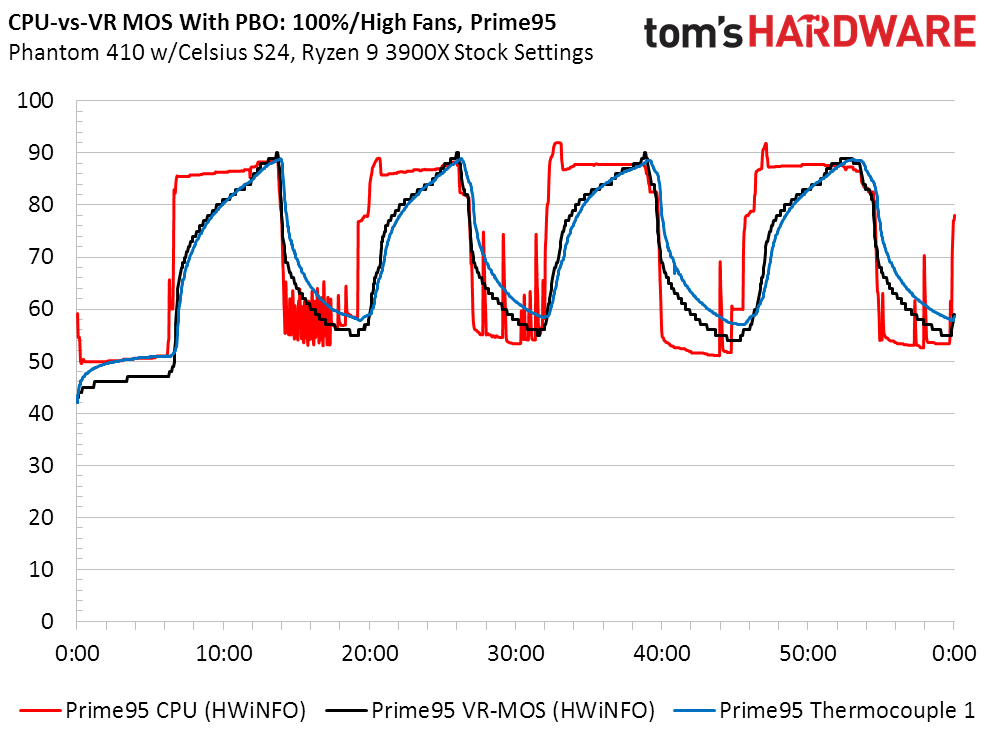Retesting The MSI MPG X570 Plus Motherboard
Is this bargain-priced board equipped to handle a Ryzen 9 3900X?
The potential for increased VR MOS temperature could stem from the use of AMD PBO overclocking, which is built into every modern AMD motherboard we’ve tested. It’s supposed to push the processor frequency and voltage to its thermal limit, assuring increased VR MOS temperature.
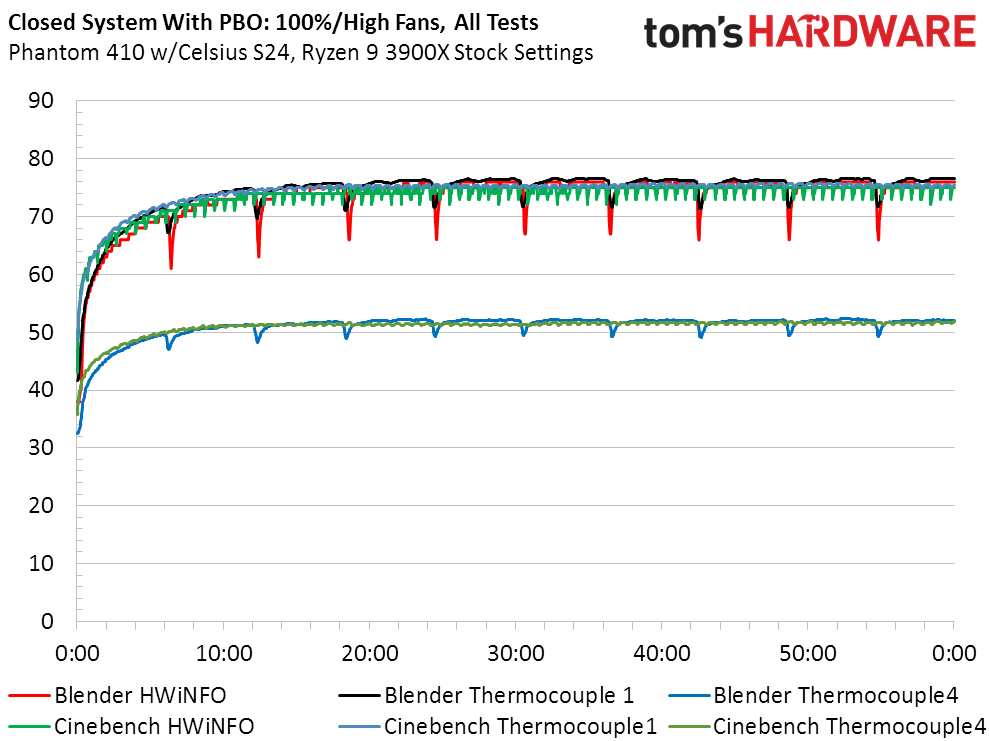
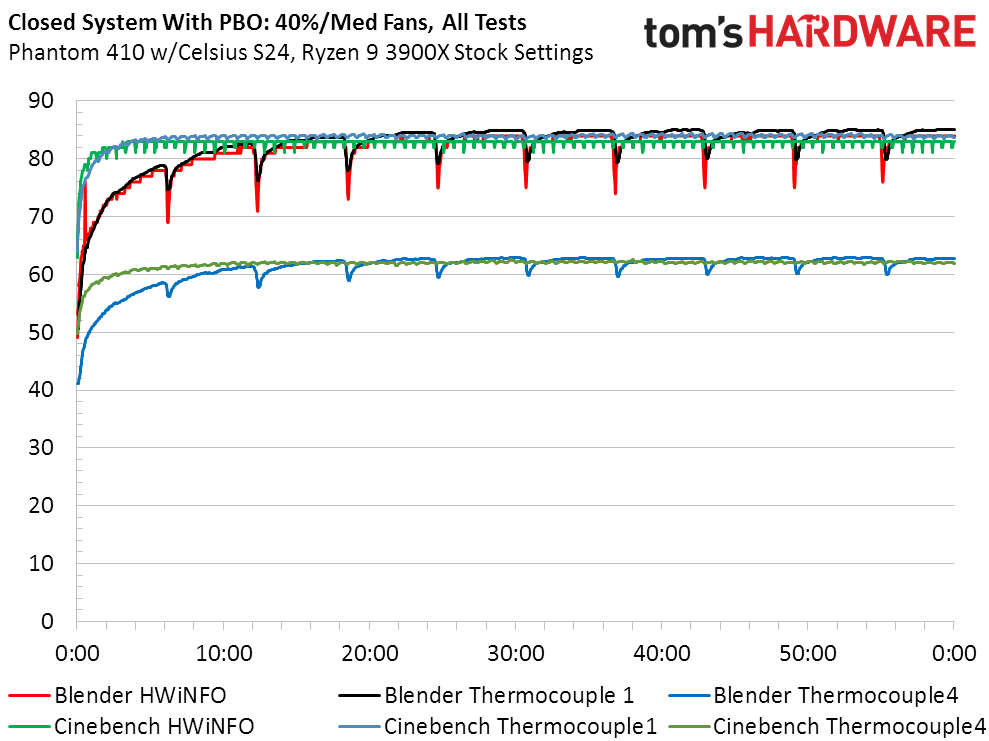
Our closed system didn’t reach its 102° default throttle point at 100% fans, and dropping the case’s onboard controller to “medium” and the system’s PWM fans to 40% got it only a few degrees warmer. Another thing that happened was that our Prime95 test effectively dropped out.
Under Prime95, PBO would spike the CPU multiplier and core voltage (up to 1.5V VID!) and hold it at its throttle point before engaging a cooldown. To eliminate the motherboard, firmware, and CPU as culprits, we applied the same load to a Gigabyte TRX40 Aorus Xtreme and a Ryzen Threadripper 3970X that was already sitting on our original testbed.
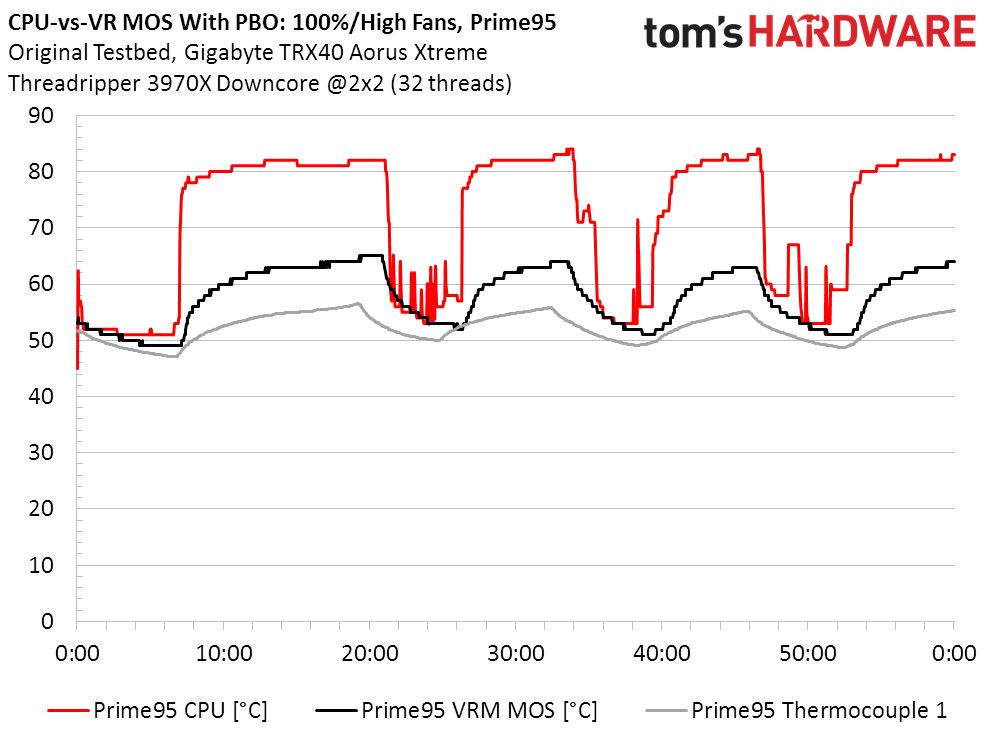
Note that in order to get this result, we had to use PBO with the 3970X in a 2x2 Downcore (16C/32T) configuration: With PBO enabled at its default 32C/64T, a more traditional throttling curve appeared.
Manual Overclocking
Given that PBO settings aren’t necessarily optimized for the lowest-stable per-clock voltage or the highest per-voltage frequency specific to a single CPU sample, we spent some time to figure out that the highest setting we could get was 4.20 GHz at 1.2625V. Anything greater caused voltage regulator thermal throttling, despite the cooling advantages that this closed case has over our original testbed.
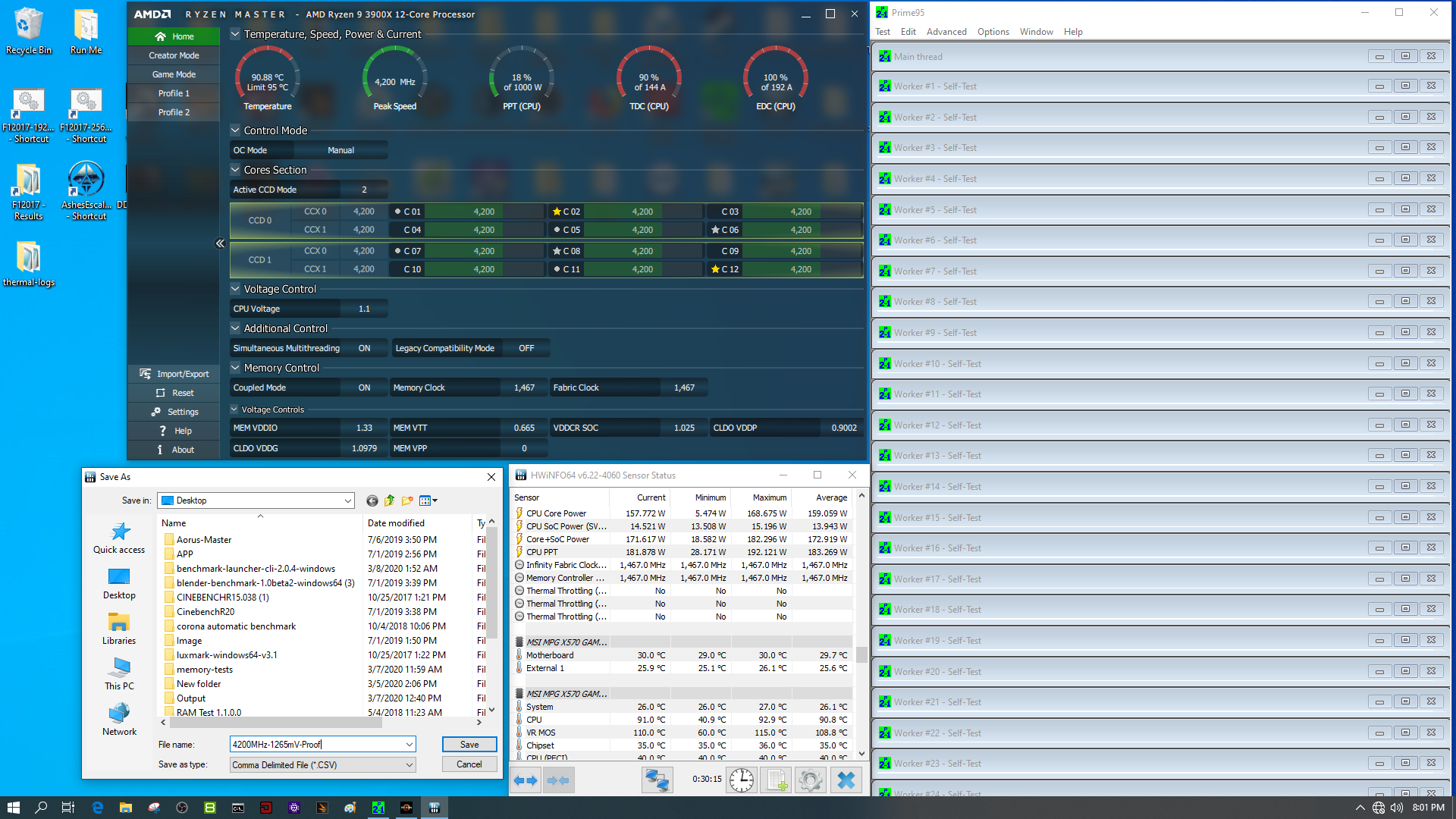
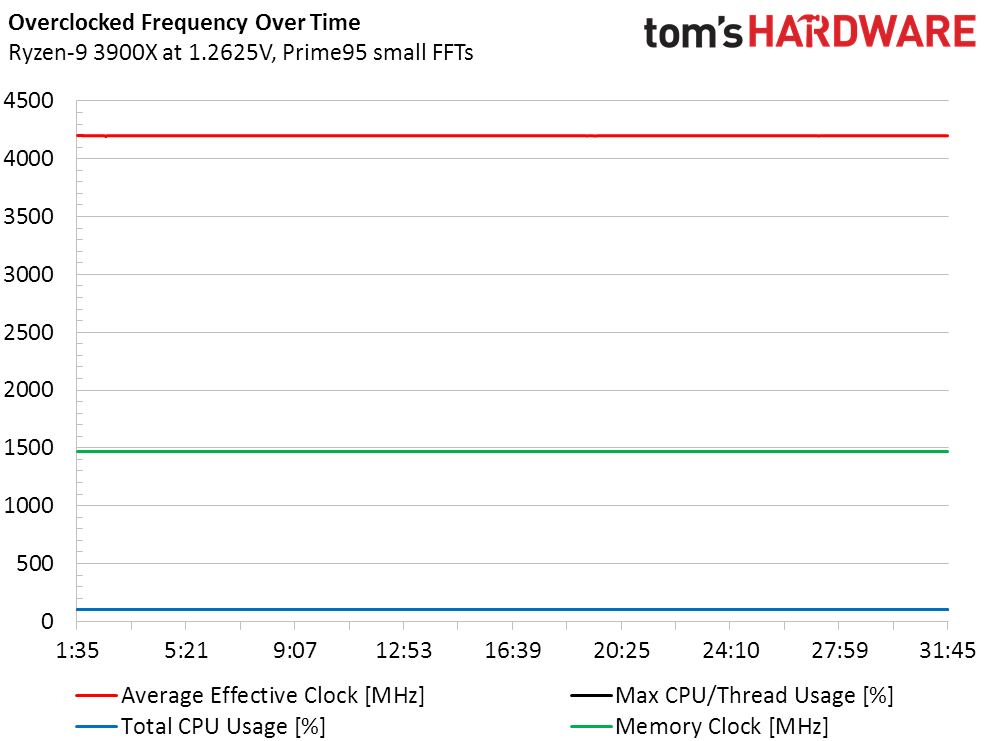

We successfully reached 115 degrees by manually overclocking the CPU, and this can be done at even lower settings: An earlier test on our original testbed yielded a lower 4.10 GHz limit at 1.175V, due to the voltage regulator running hotter on our semi-open system. Thus, while the 3900X works on this board, it’s not an ideal pairing when put into a less-than-ideal environment.
Conclusion
In our original conclusion, we noted that the MPG X570 Gaming Plus could be a bargain buy for those who simply wanted to pair a PCIe 4.0 SSD with a Ryzen 5 or 7 CPU. That narrow value advantage has since disappeared, as the cooler-running Asus Tuf Gaming X570 Plus has dropped to $165 at Newegg while the MPG X570 Gaming Plus remains $160 at Amazon. Even a small decrease in temperature would be enough to bump a board away from the margins that the 3900X-equipped MPG X570 Gaming Plus hit with our testbed cranked down to 40% fans.
Get Tom's Hardware's best news and in-depth reviews, straight to your inbox.
While none of our tests validated the extremes we had come to expect, it’s nice to know that the thermal performance of our original testbed falls directly between that of our own closed build and MSI’s worst-case scenario. MSI has acknowledged that the VRMs on the X570 Gaming Plus can run hot under some operating conditions if the board is paired with a 3900X (or beyond) and put under heavy load. The company says to look to its forthcoming X570 Tomahawk motherboard as a similarly-priced alternative to the MPG X570 Gaming Plus. However, the company hasn’t specified a release date.
In short, it's certain that the MPG X570 can run hot depending on the CPU, settings, cooling system and workload that exceed our original test conditions. Responding to the valuable feedback we received has provided a great opportunity for us to refine our motherboard testing going forward so we can better reflect the range of components someone might use in the real world.
MORE: Best Motherboards
MORE: How To Choose A Motherboard
MORE: All Motherboard Content
Current page: AMD PBO, Manual Tuning And Conclusion
Prev Page Exploring Test Methods And Aiflow-
Lutfij Where do you see mention of the board in the review(linked above) being awarded an Editor's Choice?Reply -
Crashman Reply
I wish we had tested it. The board Asus sent was priced significantly higher, and even the non-WiFi version of the board Asus sent was $15 more costly at the time of the review.refillable said:ASUS TUF Gaming or Prime-P X570 deserves the editor's choice, not this one.
But the later board dropped $10 after the original review, so the original review's value assessment is a snapshot of bargain pricing for that specific time. -
refillable ReplyCrashman said:I wish we had tested it. The board Asus sent was priced significantly higher, and even the non-WiFi version of the board Asus sent was $15 more costly at the time of the review.
But the later board dropped $10 after the original review, so the original review's value assessment is a snapshot of bargain pricing for that specific time.
I see. I am really glad you decided to re-test this and removed the editor choice award for an obviously inferior board. -
Crashman Reply
The data presented here shows that the original data was correct. The new problem for the board is that it is no longer price competitive.refillable said:I see. I am really glad you decided to re-test this and removed the editor choice award for an obviously inferior board. -
refillable Reply
It was correct, but it was incomplete. I feel like it takes a Ryzen 9 to show how inferior the board is to a slightly more expensive board. Now you have the full picture and different conclusions and I appreciate that (regardless of the price drop).Crashman said:The data presented here shows that the original data was correct. The new problem for the board is that it is no longer price competitive. -
Crashman Reply
The Ryzen 9 heat estimates from the original article were shown accurate in the first chart of this article. We understand that some users would prefer to see a worst case scenario rather than a typical case, but also realize that most people building a PC have read enough to understand the basics of system cooling.refillable said:It was correct, but it was incomplete. I feel like it takes a Ryzen 9 to show how inferior the board is to a slightly more expensive board. Now you have the full picture and different conclusions and I appreciate that (regardless of the price drop).
All of that is water under the bridge concerning the award, since competing boards are now cheap enough to knock this one out of contention. -
whisperhorse just imagine the amount of people who bought the Gaming Plus based on the original, or even this (by March 2020) updated, yet still too forgiving review, and are now sitting on top of a 16 or 32GB kit of DDR4 3200, good SSD, a decent graphic card, serviceable power supply.... with an ageing 3600-3700X... and this motherboard.Reply
They could be buying a 5800X3D for 300 bucks total when accounting the sale of their CPU, and having the BEST gaming CPU on the market tied with Intel's, on a 3yo+ platform. Guess what, they are restricted to the 5700, which came out recently, while even the 5800X non-3D which was out for almost 2 years was not a drop in replacement to this board because it would overheat VRMs with PBO enabled...
I don't know what's going on here really. I think it's OK you guys addressed the criticism in a new article, but it's totally unacceptable that you didn't go the extra mile and further fixed the original article stating very clearly: this top tier chipset motherboard will not work well with over 65W TDP chips, especially in cheap cases with bad attention to proper airflow.
It baffles me that a publication which can identify serious reviewers in other fields, who have not only consistent but also visionary test methodologies, such as the amazing Aris in the PSU category, would try to save face for a really poor review with bad excuses, sarcastic subtitles arguing thermal couples are a step "up" (SIC, quotes included) because somehow having the same temperature in ONE MOTHERBOARD proves all motherboard sensors are "correctly placed" and "operated properly" (now that's good sarcasm, see?). Anyone who does multiple motherboard reviews will tell you the only way to properly validate results is using thermal couples, not just HWiNFO and/or FLIR. Only flip-chip BGA components may suffer slightly from thermal couple sensing, but then again, nothing external can sense that properly. -
Crashman Reply
Because all of the negatives you heard were a lie. The board performed fine with a 3800X in a regular case. The guys who said it overheated were testing it without airflow. And it was only recommended as the cheapest acceptable solution (ie, for value).whisperhorse said:just imagine the amount of people who bought the Gaming Plus based on the original, or even this (by March 2020) updated, yet still too forgiving review, and are now sitting on top of a 16 or 32GB kit of DDR4 3200, good SSD, a decent graphic card, serviceable power supply.... with an ageing 3600-3700X... and this motherboard.
They could be buying a 5800X3D for 300 bucks total when accounting the sale of their CPU, and having the BEST gaming CPU on the market tied with Intel's, on a 3yo+ platform. Guess what, they are restricted to the 5700, which came out recently, while even the 5800X non-3D which was out for almost 2 years was not a drop in replacement to this board because it would overheat VRMs with PBO enabled...
I don't know what's going on here really. I think it's OK you guys addressed the criticism in a new article, but it's totally unacceptable that you didn't go the extra mile and further fixed the original article stating very clearly: this top tier chipset motherboard will not work well with over 65W TDP chips, especially in cheap cases with bad attention to proper airflow.
It baffles me that a publication which can identify serious reviewers in other fields, who have not only consistent but also visionary test methodologies, such as the amazing Aris in the PSU category, would try to save face for a really poor review with bad excuses, sarcastic subtitles arguing thermal couples are a step "up" (SIC, quotes included) because somehow having the same temperature in ONE MOTHERBOARD proves all motherboard sensors are "correctly placed" and "operated properly" (now that's good sarcasm, see?). Anyone who does multiple motherboard reviews will tell you the only way to properly validate results is using thermal couples, not just HWiNFO and/or FLIR. Only flip-chip BGA components may suffer slightly from thermal couple sensing, but then again, nothing external can sense that properly.
The truth is that when confronted by a site that didn't care about real-world ventilation, MSI decided to discard this single product to save its reputation...from unduly harsh criticism. That's why, in order to make a system that was bad-enough to justify that other group's findings, MSI built a system with no intake fans and a single-fan radiator mounted on the rear panel. MSI then said that they verified those findings under that condition. But does that even sound like a cooling configuration that someone would run with an upper-spec CPU?
The original review's test platform had been configured to produce similar voltage regulator temperatures to the site's 2010 reference PC, which had a Corsair Graphite 760T case and a Noctua NH-U12 if I recall correctly. So we automatically knew that guesses about that test system having "too much" airflow weren't realistic. The follow-up article showed that a typical closed case system with dual-fan radiator actually cools the voltage regulator far better than the platform used in the original article.
Given that follow-up article's real-world build outperformed the original test platform, it sounds to me like you're trying to make excuses for another site whose results didn't adequately represent the airflow of a real-world build.
